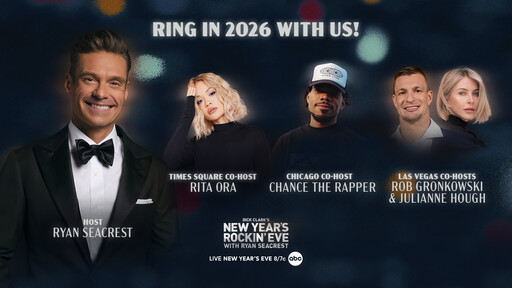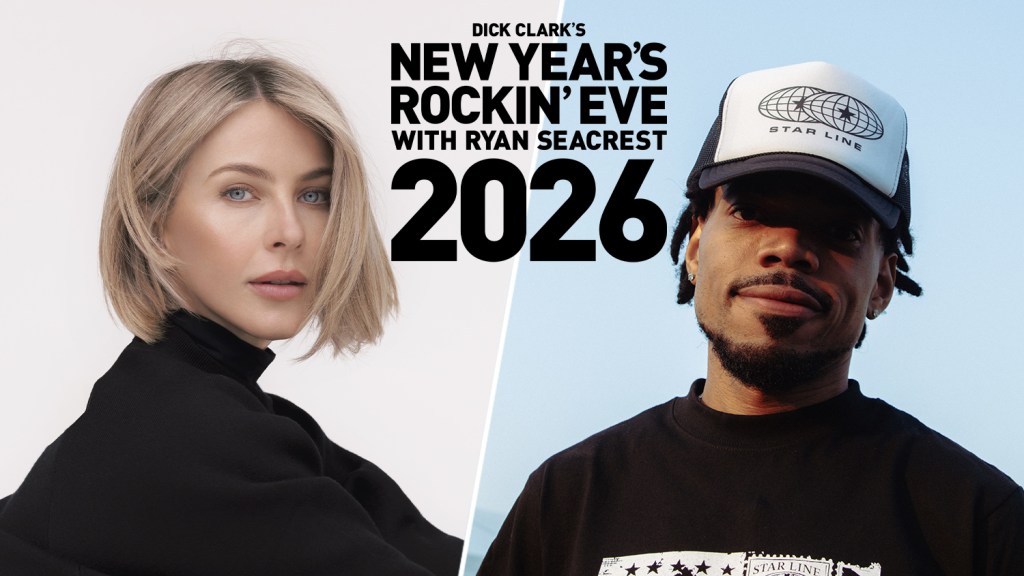So What Are We REALLY Looking At With This New ‘Rockin’ Eve’ Lineup?
Let’s not kid ourselves. You didn’t click on this because you were overcome with joy that Rob Gronkowski would be slurring his way through a teleprompter feed from Miami. No. You’re here because you felt it too. That nagging, uncanny valley feeling that something is deeply, profoundly wrong with this picture. And you’re right. Because this isn’t a hosting lineup; it’s a demographic spreadsheet brought to terrifying life, a Frankenstein’s monster of celebrity parts stitched together in a boardroom by executives who see human culture as nothing more than a series of quarterly revenue goals. It’s a joke.
And the joke is on us. They’re not even hiding it anymore. They’ve dispensed with the pretense of finding charismatic, singular talents to guide us through a culturally significant moment. That’s old-world thinking. That’s risky. Instead, they’ve assembled a committee. A panel. The kind of thing you create when you have absolutely zero faith in any one person’s ability to hold an audience, so you throw a handful of vaguely recognizable faces at the wall, praying something sticks. But this isn’t just creative cowardice. It’s a calculated act of cultural homogenization, designed by the corporate machine to be so broad, so inoffensive, and so perfectly balanced that it means absolutely nothing at all.
The Demographic Checklist
Because you have to follow the money. Look at the pieces they put on the board. You have Chance the Rapper, the designated “cool, but not too scary” urban outreach. He’s a safe bet, a guy who had his cultural moment years ago but still carries the brand recognition of being a Grammy winner, perfectly sanitized for a prime-time audience that probably hasn’t listened to a full album since 2016. He ticks the box. Then there’s Julianne Hough, the living embodiment of network television synergy. She’s the girl-next-door, the squeaky-clean former dancer who can smile on cue and read ad copy without a single flicker of genuine emotion. She represents the legacy audience, the people who watch ABC out of habit, not passion. She’s the safety net. She checks another box.
And then the absurdity dials up. Rob Gronkowski. A retired football player famous for spiking footballs and embodying a kind of frat-boy caricature that appeals directly to the 18-34 male sports-betting demographic that advertisers are desperate to reach. He’s not a host. He’s a walking beer commercial, a human billboard for FanDuel and testosterone supplements. He’s there to keep the dads from changing the channel. Box checked. And finally, Rita Ora, the international import, a pop star who has built a career on being professionally adjacent to fame rather than a driving force of it. She provides a veneer of global appeal and fulfills some contractual obligation buried deep within the Disney-verse, a strategic placement by a talent agency flexing its muscle. Every single one of them is a product, a carefully selected ingredient in a flavorless stew cooked up by the marketing department. This has nothing to do with entertainment. It’s about audience capture.
But Aren’t They Just Trying To Make a Good Show For Everyone?
That right there is the most dangerous lie the modern media sells us. The idea of “a show for everyone.” A show for everyone is, by definition, a show for no one. It is a nullity. A void. It is content so terrified of offending a single person, of displaying a single sharp edge or an ounce of genuine personality, that it sands itself down into a smooth, featureless orb of pure, unadulterated beige. This isn’t a pursuit of quality; it’s a frantic exercise in brand safety. Because the real client here isn’t the audience. It’s the advertisers. The show is merely the dead air between the commercials.
And what do advertisers want? They want a sterile environment. A predictable, controversy-free space where they can hawk their insurance plans and fast-food monstrosities. Ryan Seacrest is the master of this universe, a man so polished and devoid of any discernible inner life that he’s become the perfect vessel for corporate messaging. But even he can’t do it alone anymore. The audience is too fractured. So they build this team of surrogates around him, each one a walking, talking brand ambassador for a different market segment. They aren’t hosts; they are human pop-up ads. Their job isn’t to entertain you; it’s to hold your attention just long enough for the next commercial break. It is the most cynical transaction in media.
The Death of Authenticity
Remember when New Year’s Eve felt, even slightly, spontaneous? When Dick Clark felt like a genuine, calming presence guiding the country through a shared moment? That wasn’t an accident. It was the result of a singular, trusted personality. That trust has been eroded, not by the audience, but by the networks themselves. They’ve spent decades force-feeding us manufactured reality shows and algorithm-driven content, training us to accept the artificial over the authentic. And this hosting panel is the endgame. It’s the final admission that they no longer believe in the power of a single human connection. They believe in data points. They believe in focus groups. They believe in mitigating risk.
Because a real personality might say something unscripted. A real personality might have an actual opinion. A real personality is a liability. This group? They are not liabilities. They are assets. Their public images have been meticulously curated. Their social media feeds are managed by teams of publicists. They will hit their marks, read their lines, and smile for the camera, all while the soul of what was once a shared cultural tradition is quietly hollowed out and sold for parts. It’s a televised lobotomy, and we’re all invited to watch.
You Keep Mentioning The ‘Machine’. Who Is Pulling The Strings Here?
Oh, the machine is vast and it is hungry. At the top, you have the parent company, Disney, a global behemoth that doesn’t just own ABC, but also Marvel, Star Wars, ESPN, and a dozen other cultural properties. For them, ‘New Year’s Rockin’ Eve’ is not a standalone show; it’s a two-hour commercial for the Disney ecosystem. It’s a “synergy” opportunity. A platform. Don’t be surprised if Chance the Rapper suddenly has an animated series on Disney+, or if Julianne Hough is announced as the host of another ABC reality competition. This isn’t casting; it’s corporate strategy. It is vertical integration made manifest.
Beneath Disney, you have Dick Clark Productions, now owned by Penske Media Corporation, a group that also owns Rolling Stone, Variety, and Billboard. They are in the business of manufacturing fame and controlling the narrative around it. They have relationships with all the major talent agencies—the CAAs, the WMEs of the world. And those agencies are constantly horse-trading, pushing their clients into these high-visibility slots. One host gets a spot on NYE in exchange for another client agreeing to a lower salary on a different network project. It’s a complex web of favors, threats, and backroom deals that has absolutely nothing to do with who would be the best person for the job. It’s about who has the most leverage.
Follow the Paper Trail
And that’s the real story. The corruption here isn’t a brown paper bag full of cash. It’s far more insidious. It’s the corruption of intent. The entire process is tainted from the start. A producer at DCP doesn’t sit down and think, “Who would be a fun, engaging host?” They sit down with a list of demands from the sales department, a list of synergistic priorities from the parent company, and a list of available, brand-safe clients from the major talent agencies. The decision is made before the first creative meeting ever takes place. They are simply filling slots in a pre-approved template. A template for mediocrity.
And it’s a self-perpetuating cycle. The more they produce this kind of bland, committee-driven content, the more the audience becomes accustomed to it. Standards drop. Expectations wither. And the machine gets exactly what it wants: a docile, uncritical audience ready to consume whatever lukewarm content is placed in front of them, just as long as it’s attached to a familiar face. They are not creating culture; they are strip-mining it.
So, What Does This Mean For The Future of Live Television?
This is the blueprint. This is the new normal. We are witnessing the death of the event and the birth of the asset. Live television, once the last bastion of spontaneous, shared experience, is being systematically dismantled and reassembled into a series of predictable, easily monetizable brand activations. The Super Bowl halftime show, the Oscars, the New Year’s Eve countdown—they are all suffering the same fate. They are becoming too valuable to be left in the hands of creatives. They must be managed, controlled, and optimized for maximum shareholder value.
The ‘panel-fication’ of everything is the most obvious symptom. Why rely on one host when you can have four, each targeting a different quadrant of your marketing data? It spreads the risk. It diversifies the portfolio. It is the language of finance, not art. And the result will be a future where every major television event feels exactly the same: a glossy, overproduced, and utterly soulless affair, populated by a rotating cast of interchangeable celebrities who are famous simply for being famous. There will be no surprises. No danger. No joy. Only the cold, relentless hum of the corporate machine, counting down to midnight, counting down to the next ad break. The ball may drop in Times Square, but the standards dropped long, long ago.


